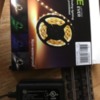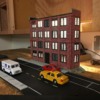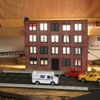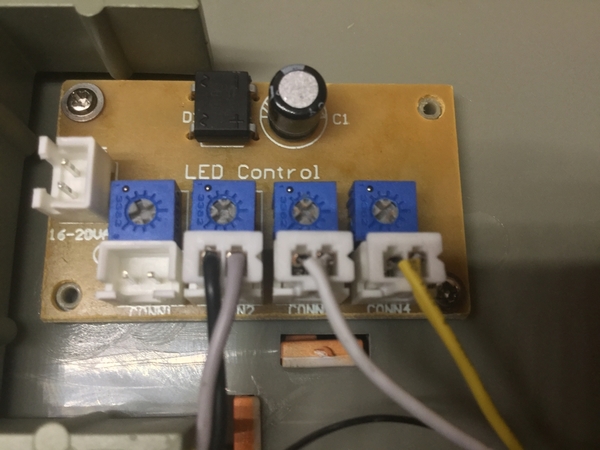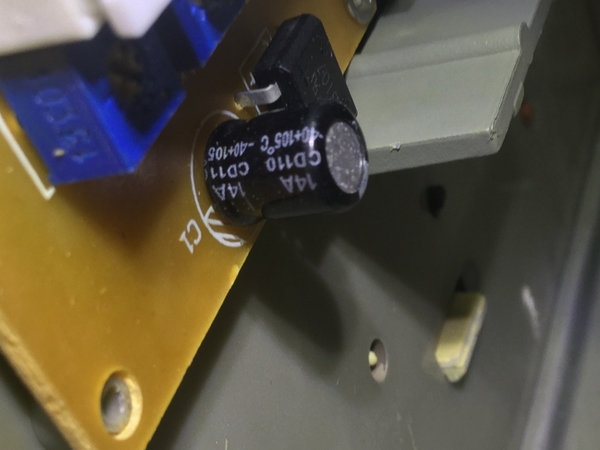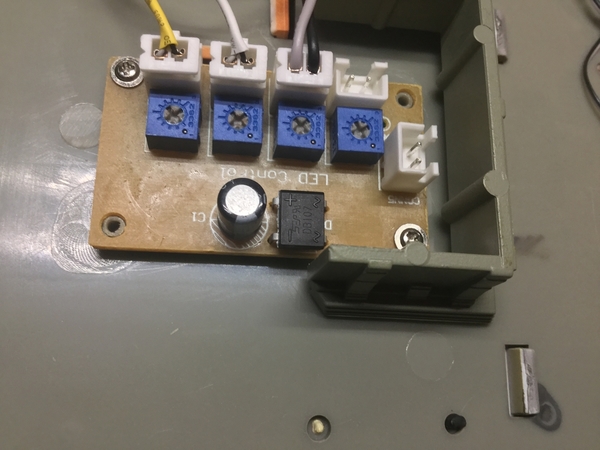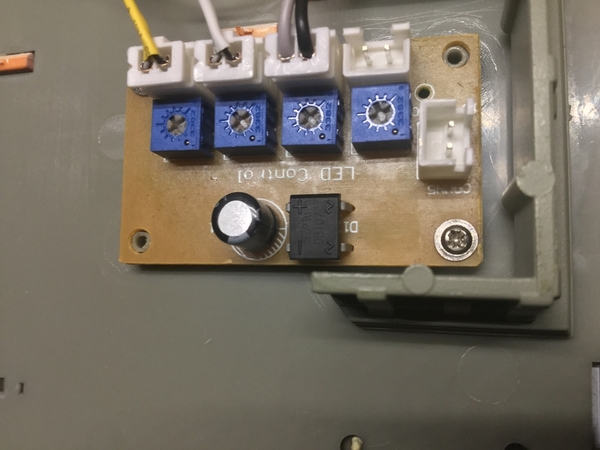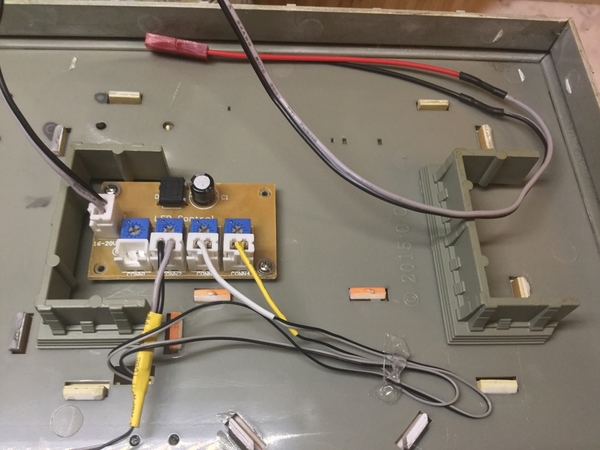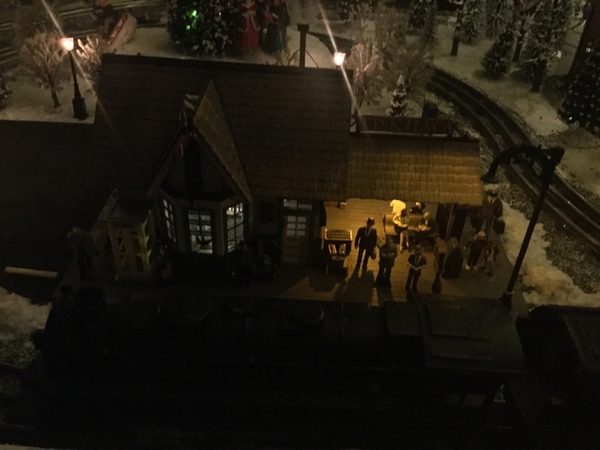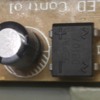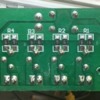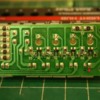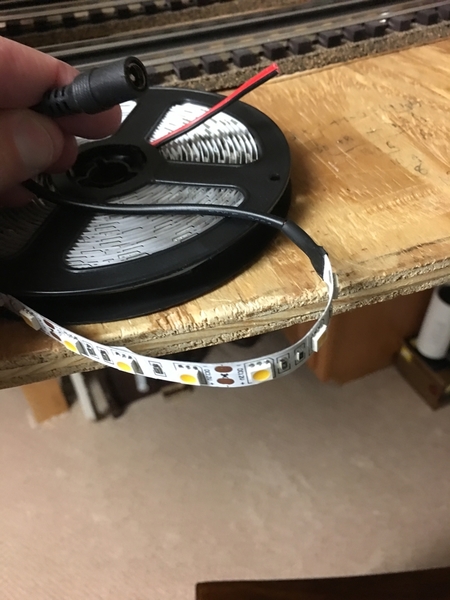 can someone help me with this spool of lights - I know I can cut them every three but what from there - I guess you can solder wires to one end of a set of three and then to a power source? Before I broke them up wanted to be sure of what I was doing
can someone help me with this spool of lights - I know I can cut them every three but what from there - I guess you can solder wires to one end of a set of three and then to a power source? Before I broke them up wanted to be sure of what I was doing
Replies sorted oldest to newest
Yes you cut them at the solder pads which are every three leds. They sell connectors for the cut sections, or you solder wires onto those pads that are left.
I soldered mine with wires to use inside of my passenger cars. I put them on circuits to prevent over powering them and to control their brightness.
There are plenty of posts about this in the electrical forum. Henning's trains sells a control board for inside of cars too.
You will want to power these with DC voltage; not AC.
Match the voltage from the power supply to the voltage rating of the strip (could be +12vdc).
You should be able to light the whole string without any trouble. They don't use much current.
I have extra connectors I can send you if you don't want to solder.
Those look like the bright LED's, if you're using them for passenger cars, they're gonna' be pretty bright! ![]() I use the 3528 LED strips, those look like the 5050 LED's. They consume more power than the 3528 strips, and will be much brighter.
I use the 3528 LED strips, those look like the 5050 LED's. They consume more power than the 3528 strips, and will be much brighter.
Okay - the electrical part of this hobby is not my thing so bear with me.
Some more facts for you....
using them for buildings not passenger cars
they are warm white yes they appear to be 5050
I have attached a picture of a power supply I found lying around - it lights them up but wanted to be sure it was enough over time What am I looking for to determine that?
lights are 12v
my plan is to cut lights appropriate for building (in 3’s) then clip or solder wires and run to next building - repeat at next building etc and power all with this one source
John - sure I would like to try those clips if you have excess Let me know how much?
Thanks
michael
Attachments
msp posted:...
I have attached a picture of a power supply I found lying around - it lights them up but wanted to be sure it was enough over time What am I looking for to determine that?
I'm not seeing the photo. If you do post one, useful if we can read the make/model or any labeling referring to Volts, Amps, Watts and the like.
Photo posted
The LED strip connectors are easy to use and provide reliable connections, at least in my experience. The connectors require no soldering to attach to the strip, just snap the lid closed like a clam shell. They are inexpensive on the bay. I tend to use individual LEDs to light my buildings. I use the strips where I desire uniform lighting like for loading docks, subway platforms, etc. I haven't branched out to passenger cars yet but that is another application. Follow GRJ advise on brightness and color temperature. I would do a test run in one of your building to make sure you're getting the desired effect.
From what I can tell from your LED strip manufacturer's website, your 5-meter (300 LEDs, 100 3-LED segments) 5050 LED strip consumes 40 Watts...or 8 Watts per meter.
Your 12V power adapter can supply 750 mA or 0.75 Amps. Watts = Volts x Amps, so that's "only" 9 Watts.
So your adapter can power about 1 meter of your 5 meter strip. That's about 60 LEDs or 20 3-LED segments.
If you look at the manufacturer website they recommend a 60 Watt power supply adapter.
Stan - perfect
thanks
shorling posted:TheLED strip connectors are easy to use and provide reliable connections, at least in my experience.
Steve, do you have a link to the connectors?
I try to stay current with the LED discussion, especially when GRJ or Stan are supplying the data/info. But I've been off the forum for a while and missed that one.
Thanks.
Ok guys - I’m pumped up second kit I have built first installation of lights
let me know what you think - first off it might be a little bright. Actually looks brighter in pic than in real life
other than that I would love feedback. Yes there will be a background to cover up shelving.
That is 15 0f those 5050’s across the top
Attachments
Good job!
Pingman posted:shorling posted:TheLED strip connectors are easy to use and provide reliable connections, at least in my experience.
Steve, do you have a link to the connectors?
I try to stay current with the LED discussion, especially when GRJ or Stan are supplying the data/info. But I've been off the forum for a while and missed that one.
Thanks.
Here's a few:
f:0" target="_blank">https://www.ebay.com/itm/10X-F...Swr8xaAohb:rk:3![]() f:0
f:0
There were a lot of choices
msp posted:Ok guys - I’m pumped up second kit I have built first installation of lights
let me know what you think - first off it might be a little bright. Actually looks brighter in pic than in real life
other than that I would love feedback. Yes there will be a background to cover up shelving.
That is 15 0f those 5050’s across the top
Looks great, I have one recommendation. Arrange to have a few windows dark and maybe reduce the intensity of the lighting in a couple to simulate real life.
Building looks great. I like the road, also.
there is another thread discussion about using too much power on a menders building. As stan2004 pointed out above...a certain power source will supply power to a certain number of lights....do i need to make sure to use the full number of lights in other words...if I use a string of less lights than my power source is capable of supplying do i run a risk of overpower and blowing them.
Hope that makes sense.
msp posted:there is another thread discussion about using too much power on a menders building. As stan2004 pointed out above...a certain power source will supply power to a certain number of lights....do i need to make sure to use the full number of lights in other words...if I use a string of less lights than my power source is capable of supplying do i run a risk of overpower and blowing them.
Hope that makes sense.
No, the voltage is fixed, and only the current required for the existing lights will be used. It's the same as if you plug a 15 watt lamp into your 120V socket at home. The socket can supply up to around 1800 watts, but it only supplies enough power to light the 15 watt lamp.
thanks.
so what is the difference with a power source to a Menards building? Why is there a danger of supplying to much power to that?
There is no danger unless you supply the wrong voltage. The Menards buildings are rated for 4.5 VDC. If you connect a 4.5 VDC power supply with a 1,000 amp capability, the building will work fine with no damage. When you're connecting power to devices, you have to be mindful of the voltage rating of the device.
So, it’s not wise to power the Menards building lights with more than 4.5vdc, and don’t use an AC power supply at all.
Correct, they want 4.5 VDC, AC is NOT a good idea. Obviously, you can run the power supply from AC, it just needs to provide DC to the load. ![]()
msp posted:so what is the difference with a power source to a Menards building? Why is there a danger of supplying to much power to that?
If you were researching earlier OGR threads about LED building lighting, a couple years ago there was a spirited discussion about power supplies for Menards buildings. As the guys state above, the Menards buildings expect 4.5V DC. But the power adapters Menards sold were of the unregulated ilk; with no buildings or only a few small buildings attached the voltage would be substantially higher than 4.5V and guys were reporting building failures. Menards pulled the power adapters from the shelves and for several months you couldn't buy a Menards adapter. They re-introduced adapters of the regulated ilk; these put out 4.5V irrespective of what was attached (within the power capability).
Should I buy from Menards or is there a supplier with better price?
You can get 5 meter LED strips in the color of your choice from AliExpress for a couple of bucks.
Using the search term “4.5vdc power supply” will show you a large number of options from $3 to $20 or more. So pick the one(s) you like with “free shipping” added in, I suggest. Also, to Stan’s point above, at the necessary 4.5vdc, pick an amperage that will power all the leds(buildings) you want with the least number of units. I would think a minimum of 1 Amp(1000mA) per power supply. Depends on the buildings but as has been reported the building requirements on current vary. Some buildings with variable signs and the like might require up to 5A supplies. In my application, I use a single power supply to terminal strips, then use buck converters to regulate each(or more) buildings to suit my taste. Which runs much less bright than yours BTW. So make your best deal and “go to town”.
Don’t forget to look only for regulated voltage supplies.
If you're having problems finding the 4.5V supply, a 5V one with a diode gets the job done as well. ![]()
So can I mix a woodland scenics building with the led lights?
In other words I run my 12v 2A powerpack to the strip lights in bldg A then connector wires to building B which is a woodland scenics building then on to building C which is using strip lighting?
WS pre-lit buildings claim compatibility with their proprietary Just-Plug(r) lighting system so you can't apply 12V DC directly to the building's wiring. But if you mean installing your own 12V LED strip(s) segments into a generic unlit WS kit building then sure.
No I want to use their lights. But I don’t want spend for their plug and play. Can’t I use a train power pack?
When WS introduced their system a few years ago I harassed/badgered ![]() another forum member to open one up and post photos here so that I could see how they did it. Assuming that's what we're talking about then you can use a 5 cent resistor to limit the current into the pre-installed LED lights. Perhaps someone has already done this and can offer suitable resistor values. Or, depending on what you have on your bench (meter, bag of random resistors, DC train transformer, etc.) we can come up with a solution.
another forum member to open one up and post photos here so that I could see how they did it. Assuming that's what we're talking about then you can use a 5 cent resistor to limit the current into the pre-installed LED lights. Perhaps someone has already done this and can offer suitable resistor values. Or, depending on what you have on your bench (meter, bag of random resistors, DC train transformer, etc.) we can come up with a solution.
You don't want to use a train power pack without some kind of mechanism (i.e., a resistor) to limit the current flowing into the LEDs. A tiny change in voltage applied to an LED can result in a large change in current which will momentarily seem brilliant until the LED dies.
Geez - I’ll just get the plug and play it is not that big of a deal just thought I could get by and string these together. More efficient, less plugs etc. KISS is the best principal for me and electricity
thanks
msp posted:No I want to use their lights. But I don’t want spend for their plug and play. Can’t I use a train power pack?
Something like this would be handy for led lighting in general. Says regulated which is ideal.
Here are some pics of the pre-just plug WS Depot, purchased Jan ‘17. The building has three leds and, as you see, an open control. Probably a generic board for different buildings. It had a pigtail and was touted to run on 12-18v AC/DC. I think I got everything(![]() ) looks pretty basic. Let me know if you need another shot or angle. Edit: pulled it apart and took shot of back of board and add closeup of bridge ID. Might be useful.
) looks pretty basic. Let me know if you need another shot or angle. Edit: pulled it apart and took shot of back of board and add closeup of bridge ID. Might be useful.
Attachments
Props to TedW for the photos; a genuine public service.
okay so i have the WS PNP....so to light an already pre lit WS building I don't need the single LED it comes with so do I just cut off the LED and attach the two wire coming from the building to the wire from the PNP? All videos show how to plug in that is the obvious part what if the building already has lights? I am guessing just cut the wire splice in and go....but....
thanks for the help
Couldn’t this board be the beginnings of the just plug system by separating it out of the building(s) and using it as a hub? I have ordered the light hub, the expansion hub and the sequencing hub, should be here in a week or so. @stan2004 wanna do a research project? I’ll send them to you.
In the FWIW department, I don't have the WS lighting system, but I think it's a pretty neat system and doesn't seem to me to be too expensive for all that it does and the thought and design they put into it. My LHS has had a display for a while now, you can fiddle with it, I did (and still do) and was impressed. I like to tinker and do things with components (like Stan, GRJ and others post about doing), but the WS system may yet get to me...it's pretty close right now.
Aha! First time I've seen the guts of the building with individual "zone" brightness control. Thanks for posting them! ![]()
Yes, that board performs the same function as the 4-control Light Hub. But obviously your board is located inside the structure so you don't have the external easy accessibility and with larger finger-controllable brightness vs. a tiny screwdriver.
If it's still accessible, in the interest of research, could you read off the value of the capacitor which should be printed on the component of the right arrow; the lettering would say some number "uF" and some number "V". And, could you read off the value of the adjustment control pots which are likely printed on the side of the pot. The 3362 stamped on the top of the blue pot is the family number but the exact resistor value should be printed somewhere on the component. I show another 3362 component in the inset with what the lettering might look like.
I found this earlier OGR thread which shows the front/back of the Light Hub circuit board though I can't seem to find the original OGR thread I refer to where I got another forum member to post these photos in the first place.
https://ogrforum.ogaugerr.com/topic/led-light-hub
So I think we can make progress without your having to send me hardware during the holiday shipping rush! Additionally, I found the following thread where some guy did some research for us including drawing out a schematic of the Light Hub. I can't attest to the accuracy of his analysis but it does have some additional tidbits for anyone trying a DIY enhancement to the WS system.
http://www.sumidacrossing.org/...ngLighting/WSLights/
Actually, I'm a bit confused as to what we (the collective "we") are trying to accomplish here! Obviously WS recognized a need for a plug and play system for folks that don't want to deal with all the hassles of wiring, resistors, voltage, current, blah, blah, blah. One recurring topic seems to be how to use LEDs other than those provided by WS. That is, they seem relatively expensive for what you get. To that end, see this OGR thread:
https://ogrforum.ogaugerr.com/...enics-led-nano-light
Basically, if you can work with small components and wiring you can roll your own LED assemblies that are compatible with the Just Plug system for a fraction of what WS charges.
As far as I know (someone please correct me) WS still doesn't have what I'll call a "high power" output for their Light Hub that you can hook up a common 12V LED light strip and use a Light Hub brightness knob. IMO, that would be a worthwhile discussion on how to modify a Light Hub or roll-your-own. For example, I can imagine some kind of "booster" circuit that you place between a Light Hub output and a 12V LED strip. Maybe $1 or so in components but tedious component assembly possibly requiring one of the guys to design a small bare circuit board from OSH Park or wherever.
Attachments
Due to positioning, the only number I can see/read on the pot is this one. On the two-fer one, I also got the cap info, but that was on another photo a post or two back, anyway. Of course in the earlier photos the resistors on the back side of the board are ID’d. Guess they are positioned under the pots. I found one of the power supply WS sells and thought it interesting that it was AC/AC, 16v at 1A. The OP is actually asking about daisy chaining buildings with dissimilar lighting. WS in one then led strips in the next, etc.
Attachments
Could you look again at the cap on the other side near the tip of the yellow arrow I drew in. I'm looking for a pair of values, one will be a number followed by the letter "uF" and other a different number followed by the letter "V". For example, in this photo the bigger cap is 470uF 50V, the smaller cap is 100uF 50V. The values repeat in a row so a particular number may be cut off in the middle but should repeat in a way that you can figure it out.
Attachments
Attachments
Stan I would think that cap is just a 330 or 470 uF @ 25 volt or something similar, since it's just a filter cap, right? If we are trying to replicate the circuit though it would be good to nail the SM resistor values and the pots. Maybe TEDW you could measure the resistance of one of the pots end to end, since one end is open, not connected? Just a couple of thoughts.
Rod
Got it. So for posterity:
In round numbers, this board allows individual adjustment of LED current between 0-30 mA or so with max AC input voltage. OTOH if you only have 12V DC available, cranking the control to max will only go up to about ~15mA.
Again, I'm not quite clear on where we're going with this WS stuff. But no harm in dropping bread crumbs as we stumble our way through the unknown! ![]()
Attachments
I wonder why the doubled up resistors? Did they get a good deal in 1/8W resistors? ![]()
Well, I'd think those resistors go for a fraction of a penny in production...so by doubling up it adds maybe 1 cent to the cost of each board. But this increases the power handling capability by more than double since it spreads out the resistance over a greater surface area and they have the real-estate to do so. Plus, the component cost of two x-Watt resistors might actually be cheaper than one 2x-Watt resistor. Then, apply Ohms law! ![]()
Could be, it's certainly not a normal construction technique. ![]()
to be clear...can i use the hub to power a WS building that already has lights? Meaning the 3 or 4 lights in the building (specifically Emillo's italian restaurant and Morrison Door factory) won't use more than one port on the hub can supply because they only give you one light for the Hub. Which begs the next question can I put two or three lights using one port on the hub?
Okay I have the Menards Police station and providing power with the recommended Menards 4.5 V 2000mA three pronged power source. Being that it is three pronged I imagine it will provide power to two additional buildings. I want to use the other two, to power strip lights in two additional buildings, approximately 12-15 light per building. Any issue with this?
Are the additional buildings Menards with built-in strip lights? Or are you talking about custom adding LED strips to your own structures?
If this is a DIY modification with your own strip lights, it's likely you have 12V strip lights. The Menards adapter only provides 4.5V. There are LED strip lights that operate on about 5V - much less common but they're out there. In fact, there are some Menards buildings with built-in LED strip lights and these are of the 5V variety and work at 4.5V.
There are low-cost ($1 on eBay, free shipping from Asia) voltage converters to convert from one DC voltage to another. For example, 4.5V to 12V or 12V to 4.5V.
Yes custom lights and building so yea I guess that won’t work. I have the 12 volt power supply I can use - was trying to be efficient with the 3 pronged
Ok picked these up with my Menards purchase .....how do I power them ? use same 12v power pack that I am using for strip lighting? cant take more power than strip lighting so as long as I don’t exceed proper number of lights ?
Should I be able to tell? Looked at web site didn’t help
Attachments
It appears you have 14V bulbs that draw 30 mA. These can be driven with "only" 12V DC though obviously not as bright as if driven by the full 14V. If you decide brightness is not acceptable, then need to find a higher voltage power source such as the 14V AC from Accessory output of a train-transformer.
But if brightness acceptable, then in round numbers (math skipped over), each lamppost bulb when driven by 12V DC uses about the same power as one 3-LED strip segment. Previously I suggested your existing 12V DC adapter could power 20 3-LED segments. So now it would be mix-and-match up to 20. For example, 15 LED segments (45 LEDs) plus 5 bulb lamp-posts, or 5 LED segments (15 LEDs) plus 15 bulb lamp-posts, etc.
Attachments
Thanks Stan - big help.....do you mind showing the math? I thought the 12V power might be close enough ...but how did you translate to number of bulbs?
Let me take a stab...14V x .03 = .42 watts per bulb.....we know from above 20 3 light sections required 8 volts therefore each 3 light section .4 volts? .4~.42
Ah yes. The math. Earlier in the thread I copied from your LED strip manufacturer's specs that it uses 8 Watts/meter.
Each meter contains 20 3-LED segments. So each 3-LED section uses 8W / 20 = 0.4 Watts per 3-LED section.
At 14V, your lamp-post bulbs nominally use 0.42 Watts...it will be lower when only driven at 12V so for back-of-envelope purposes let's just call it 0.4 Watts per incandescent bulb.
Whether it be harmonic convergence, divine intervention, or just dumb luck the power is about the same!
Your power source is capable of 9 Watts so it can drive 1 meter of strip LEDs. Hence I say mix-and-match (up to) 20 3-LED sections or incandescent lamp-post bulbs.
👍🏻





